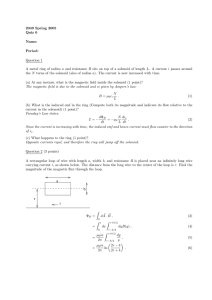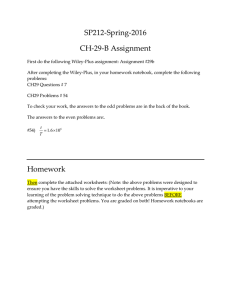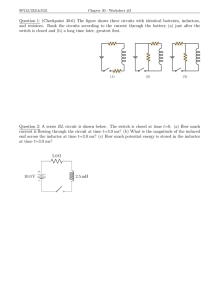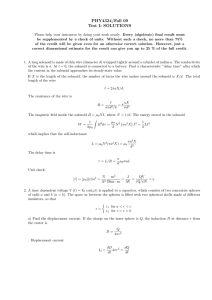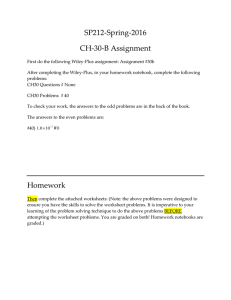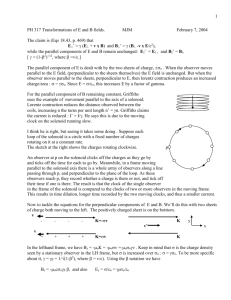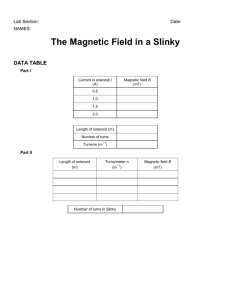Induced Electric Field for a Solenoid of Uniformly Increasing Current x
advertisement
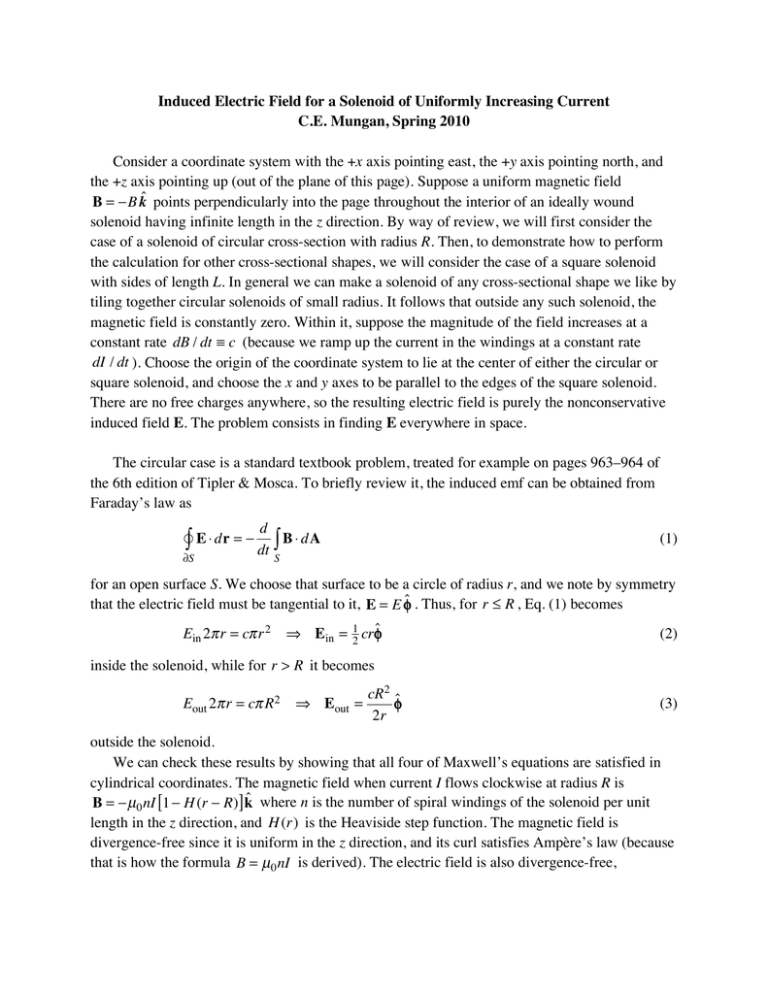
Induced Electric Field for a Solenoid of Uniformly Increasing Current C.E. Mungan, Spring 2010 Consider a coordinate system with the +x axis pointing east, the +y axis pointing north, and the +z axis pointing up (out of the plane of this page). Suppose a uniform magnetic field B = !B k̂ points perpendicularly into the page throughout the interior of an ideally wound solenoid having infinite length in the z direction. By way of review, we will first consider the case of a solenoid of circular cross-section with radius R. Then, to demonstrate how to perform the calculation for other cross-sectional shapes, we will consider the case of a square solenoid with sides of length L. In general we can make a solenoid of any cross-sectional shape we like by tiling together circular solenoids of small radius. It follows that outside any such solenoid, the magnetic field is constantly zero. Within it, suppose the magnitude of the field increases at a constant rate dB / dt ! c (because we ramp up the current in the windings at a constant rate dI / dt ). Choose the origin of the coordinate system to lie at the center of either the circular or square solenoid, and choose the x and y axes to be parallel to the edges of the square solenoid. There are no free charges anywhere, so the resulting electric field is purely the nonconservative induced field E. The problem consists in finding E everywhere in space. The circular case is a standard textbook problem, treated for example on pages 963–964 of the 6th edition of Tipler & Mosca. To briefly review it, the induced emf can be obtained from Faraday’s law as d !# E ! dr = $ dt # B ! dA "S (1) S for an open surface S. We choose that surface to be a circle of radius r, and we note by symmetry that the electric field must be tangential to it, E = E !ˆ . Thus, for r ! R , Eq. (1) becomes Ein 2! r = c! r 2 " Ein = 12 cr#̂ (2) inside the solenoid, while for r > R it becomes Eout 2! r = c! R 2 " Eout = cR 2 #̂ 2r (3) outside the solenoid. We can check these results by showing that all four of Maxwell’s equations are satisfied in cylindrical coordinates. The magnetic field when current I flows clockwise at radius R is B = ! µ0 nI [1 ! H (r ! R)] k̂ where n is the number of spiral windings of the solenoid per unit length in the z direction, and H (r) is the Heaviside step function. The magnetic field is divergence-free since it is uniform in the z direction, and its curl satisfies Ampère’s law (because that is how the formula B = µ0 nI is derived). The electric field is also divergence-free, !"E = 1 #E =0 r #$ (4) since E in Eqs. (2) and (3) is only a function of r. Finally for its curl we correctly compute ! " Ein = k̂ # ck̂ # 2 dB (rEin ) = (r ) = ck̂ = $ r #r 2r #r dt (5) inside the solenoid, and ! " Eout = k̂ # cR 2 k̂ # (rEout ) = (1) = 0 r #r 2r #r (6) in agreement with the fact that there is no magnetic field outside the solenoid. Next consider the case of a square solenoid. We expect contours of constant E ! E to be approximately circular near its center, far away from the windings. In contrast, along those boundaries the contour lines should roughly follow the square shape because if one is close to an edge of the solenoid (compared to the distances to the two nearest corners) then any effects due to those corners can be neglected so that a winding along any edge effectively becomes a long wire (with E opposite the direction of increasing current in it, just as for a linear electric-dipole antenna). Furthermore, we expect E to be zero at the exact center of the square, increase in magnitude (in a counter-clockwise direction) as the edges are approached, and then decay back to zero outside it as one gets farther and farther away from the square loop. An exact calculation (presented below) gives contours sketched at the top of the next page (produced using the command “ContourPlot” in Mathematica) that agree with these intuitive expectations. The logical way to solve the problem is to invert the order of thinking that we used for the circular case: rather than ending with calculations of the divergence and curl of the electric field, start with them. Helmholtz’s theorem (cf. Appendix B of Griffiths Introduction to Electrodynamics) provides a general method of computing a vector field if we know its divergence and curl, ' 1 "$ % E(r $ ) * ' 1 "$ - E(r $ ) * E(r) = !" ) dV $ , + " - ) dV $ , & & r ! r$ r ! r$ ( 4# + ( 4# + (7) where the (primed source) volume integrals range over all space, while the unprimed gradient and curl act on the field coordinate r. The quantity in the first brackets can be recognized as the scalar potential from Coulomb’s law, whereas that in the second brackets is the vector potential from the Biot-Savart law. In our problem there is no free charge and hence the divergence of E is zero from Gauss’ law. On the other hand, we see from Eqs. (5) and (6) that the curl of E is equal to ck̂ inside the solenoid and zero outside it. Equation (7) therefore becomes E(r) = & k̂ ) & 1 ) c ck̂ ck̂ r $ r% "#( dV % = $ # , "( dV % = #, dV % , + + 3 4! 4! 4! ' r $ r% * ' r $ r% * r $ r% (8) 0.4 0.2 0.0 - 0.2 - 0.4 - 0.4 - 0.2 0.0 0.2 0.4 using standard vector calculus identities, where the volume integrals are now only over the interior of the solenoid. Evaluating the cross-product and putting in the limits of integration, we have c E(r) = 4! ) L /2 L /2 ( ( ( " ( y " y# ) î + ( x " x # ) ĵ 2 2 2 ") " L /2 " L /2 $( x " x # ) + ( y " y# ) + ( z " z # ) & % ' 3/2 dx # dy# dz# . (9) Perform the z! integral by making the standard trignometric change of variable to θ, z ! z" # ( x ! x" )2 + ( y ! y" )2 tan $ , (10) and Eq. (9) then becomes E(r) = c 4! c î = 4! L /2 L /2 " ( y " y# ) î + ( x " x # ) ĵ % % 2 2 " L /2 " L /2 ( x " x # ) + ( y " y# ) L /2 % " L /2 L /2 dx # "2 ( y " y# ) dy# ! /2 dx # dy# % 2 2 " L /2 ( x " x # ) + ( y " y# ) % cos$ d$ " ! /2 L /2 cĵ " 4! % " L /2 L /2 dy# "2 ( x " x # ) dx # % 2 2 " L /2 ( x " x # ) + ( y " y# ) (11) . 2 2 The inner indefinite integrals are ln #( x ! x " ) + ( y ! y" ) % so that $ & E(r) = c î 4! L /2 c î 2 2 ( dx" ln $%( x # x" ) + ( y # L / 2 ) &' # 4! # L /2 cĵ # 4! L /2 ( # L /2 dy" ln $( x # L / 2 ) % 2 L /2 # L /2 L /2 cĵ + ( y # y" ) + ' 4! 2& ( ( 2 2 dx " ln $( x # x " ) + ( y + L / 2 ) & % ' # L /2 (12) dy" ln $( x + L / 2 ) + ( y # y" ) . % ' 2& 2 The remaining integrals are of the form ( ) I ! " ln a 2 + v 2 dv (13) that we can integrate by parts, ( u ! ln a 2 + v 2 ) " du = a2 2v dv , + v2 to get ( ) 2v 2 dv a2 + v2 2v 2 + 2a 2 1 "! 2 dv + 2 ! dv 2 a +v 1 + (v / a)2 I = ! u dv = uv " ! v du = v ln a 2 + v 2 " ! ( ) ( ) = v ln a 2 + v 2 (14) = v ln a 2 + v 2 " 2v + 2a tan "1 (v / a). Defining the simple functions A(x) ! L / 2 " x, B(x) ! L / 2 + x, C(y) ! L / 2 " y, and D(y) ! L / 2 + y all of which are positive inside the solenoid, Eq. (12) finally becomes E(r) = c 4! (15) ( Ex î + Ey ĵ) where E x = A ln A2 + C 2 B2 + C 2 A B A B + B ln + 2C tan !1 + 2C tan !1 ! 2D tan !1 ! 2D tan !1 2 2 2 2 A +D B +D C C D D (16) and E y = !C ln A2 + C 2 A2 + D 2 !1 C ! 2A tan !1 D + 2B tan !1 C + 2B tan !1 D . (17) ! D ln ! 2A tan B2 + C 2 B2 + D 2 A A B B We can use the Mathematica command “VectorPlot” to plot the electric field as vector arrows at different locations in space, as shown at the top of the next page. 0.4 0.2 0.0 - 0.2 - 0.4 - 0.4 - 0.2 0.0 0.2 0.4 Alternatively we can plot field lines using the command “StreamPlot” in blue on the next page. 0.4 0.2 0.0 - 0.2 - 0.4 - 0.4 - 0.2 0.0 0.2 0.4 The red field lines are circles for comparison. We see that, in contrast to the contour lines plotted earlier, the field lines are nearly circular. Acknowledgments The problem in this paper stemmed from a question that a student in Daryl Hartley’s SP212 class asked in the Fall of 2009. The solution was first arrived at by David Bowman on the PHYS-L discussion list. Bob Sciamanda was the first to plot the contour lines and field arrows, while John Mallinckrodt was the first to plot field lines along with reference circular lines. Additional discussions with John Denker, Robert Carlson, and Dan Finkenstadt helped uncover fallacious lines of thinking.
